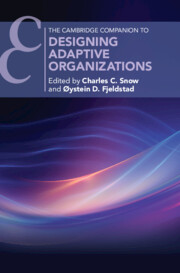Book contents
- Designing Adaptive Organizations
- Cambridge Companions to Management
- Designing Adaptive Organizations
- Copyright page
- Dedication
- Contents
- Figures
- Tables
- Contributors
- Preface
- 1 Design Thinking in Organization Design
- 2 The Open Organization
- 3 Actor-Oriented Organizing
- 4 Collaborative Conflict Management
- 5 The Platform Organization
- 6 Circular Organizing
- 7 Organizing Intelligent Digital Actors
- 8 Agile Organizing
- 9 The Global Organization
- 10 Performance-Focused Organizing
- 11 The Healthy Organization
- 12 Modern Organizing
- Index
- References
2 - The Open Organization
Published online by Cambridge University Press: 09 November 2023
- Designing Adaptive Organizations
- Cambridge Companions to Management
- Designing Adaptive Organizations
- Copyright page
- Dedication
- Contents
- Figures
- Tables
- Contributors
- Preface
- 1 Design Thinking in Organization Design
- 2 The Open Organization
- 3 Actor-Oriented Organizing
- 4 Collaborative Conflict Management
- 5 The Platform Organization
- 6 Circular Organizing
- 7 Organizing Intelligent Digital Actors
- 8 Agile Organizing
- 9 The Global Organization
- 10 Performance-Focused Organizing
- 11 The Healthy Organization
- 12 Modern Organizing
- Index
- References
Summary
The ability to organize is our most valuable social technology. Organizing affects an enterprise’s efficiency, effectiveness, and ability to adapt. Modern organizations operate in increasingly complex, dynamic environments, which puts a premium on adaptation. Compared to traditional organizations, modern organizations are flatter and more open to their environment. Their processes are more generative and interactive – actors themselves generate and coordinate solutions rather than follow hierarchically devised plans and directives. Modern organizations search outside their boundaries for resources wherever they may exist. They coproduce products and services with suppliers, customers, and partners. They collaborate, both internally and externally, to learn and become more capable. In this book, leading voices in the field of organization design articulate and exemplify how a combination of agile processes, artificial intelligence, and digital platforms powers adaptive, sustainable, and healthy organizations.
Keywords
- Type
- Chapter
- Information
- Designing Adaptive Organizations , pp. 23 - 35Publisher: Cambridge University PressPrint publication year: 2023



